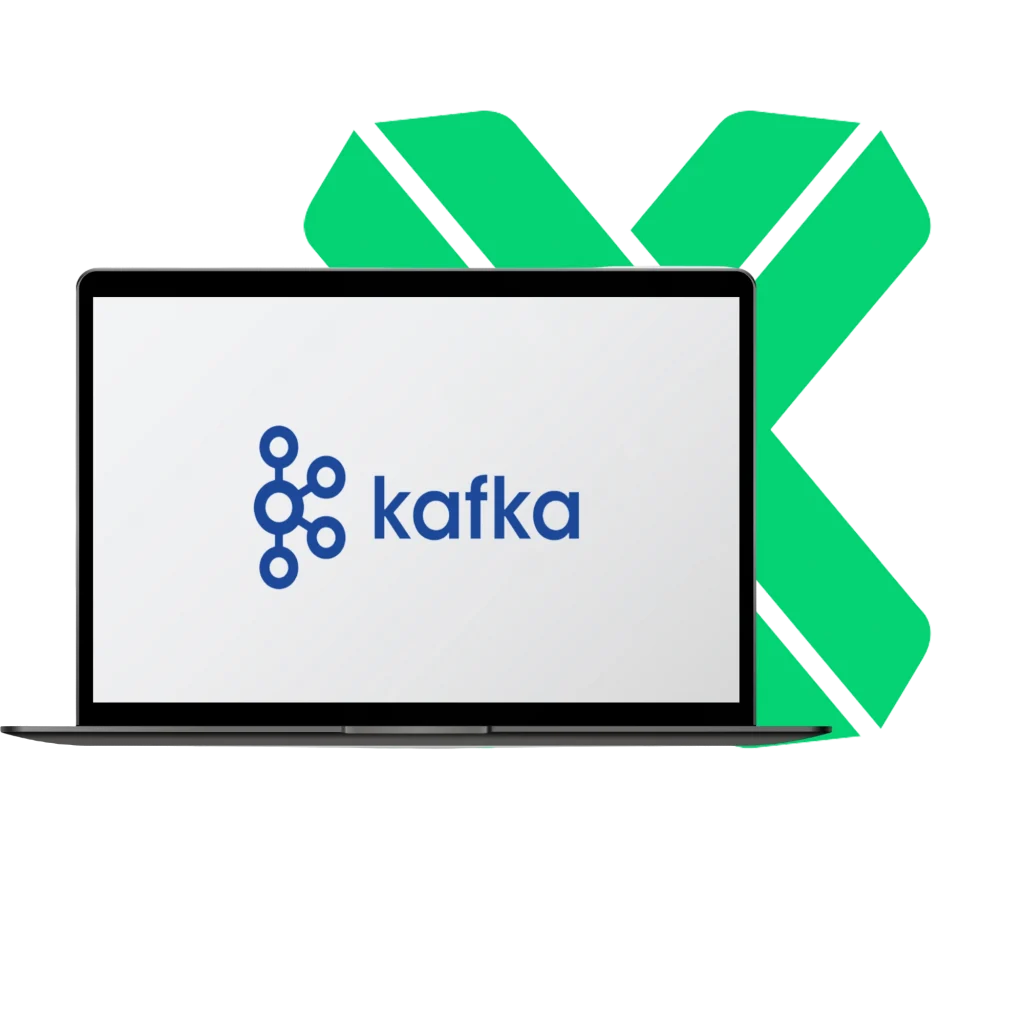KAFKA DEVELOPMENT COMPANY
Expand your Kafka development with nearshore talent.
Our Kafka development services power real-time data streaming and processing solutions. We quickly assemble skilled teams, allowing you to deliver high-performance, scalable event-driven applications with speed and efficiency.

+200 companies rely on
our 1% Top Talent

Kafka Development Services We Provide
We offer versatile Kafka development services, from building real-time data pipelines to integrating event-driven architectures. Explore our key offerings below:
Real-Time Data Streaming Solutions
We build real-time data streaming applications using Apache Kafka, enabling your business to process and analyze large volumes of data in real-time. Our Kafka solutions provide instant insights and support quick decision-making by processing events as they happen.
Kafka Data Pipeline Development
We develop robust data pipelines using Kafka, allowing businesses to seamlessly ingest, process, and distribute data from multiple sources. Our developers create scalable and reliable pipelines for log aggregation, event tracking, and stream processing.
Kafka Integration with Existing Systems
Our team integrates Kafka with your existing applications, databases, and microservices to enable smooth, real-time data flow across platforms. We help you connect Kafka to other tools like Spark, Hadoop, and relational databases for end-to-end data integration.
Event-Driven Architecture with Kafka
We design event-driven architectures using Kafka that allow your systems to respond to changes and events in real-time. This ensures high scalability, performance, and fault tolerance, making Kafka ideal for real-time analytics, transaction processing, and IoT applications.
Kafka Monitoring and Optimization
We provide ongoing monitoring and optimization for Kafka clusters to ensure top performance. Our team sets up tools to monitor Kafka’s health, manage its performance, and resolve issues, ensuring seamless data streaming and minimal downtime.
Kafka Cluster Setup and Management
We handle the setup and management of Kafka clusters, ensuring they are highly available, scalable, and secure. Whether on-premise or in the cloud, our experts configure Kafka clusters to meet your business’s data processing needs.
Why Choose Xpertsoft for Kafka Development
Nearshore Expertise
Our software developers are primarily based in Portugal, ensuring smooth collaboration with EU-based clients. With real-time communication and bilingual professionals, we provide seamless support and development services.
Broad Technical Expertise
Beyond Kafka development, our team brings expertise in data engineering, real-time processing, microservices, and cloud integration. We offer end-to-end solutions to help you build secure, scalable, and high-performance data infrastructure.
Tailored Development Solutions
We provide flexible software development services that align with your business goals. Whether you need a single Kafka developer or an entire data engineering team, we adapt to your needs and scale our involvement to fit your project requirements.
The Kafka Ecosystem We Used in Previous Work
Data Streaming and Processing
Harness Kafka’s power to process real-time data streams using these tools:
- Apache Kafka
- Kafka Streams
- Kafka Connect (for integration)
- Apache Flink (stream processing)
- Apache Storm (real-time processing)
Data Pipeline Integration
Integrate Kafka with your broader data ecosystem using these tools:
- Apache Spark (for batch and stream processing)
- Hadoop (for large-scale data storage and processing)
- Apache Nifi (for data flow automation)
- Elasticsearch (for real-time search and analytics)
- Apache Camel (for routing and mediation)
Cloud and On-Premise Deployment
Deploy and manage Kafka clusters in cloud or on-premise environments:
- Confluent Kafka (Kafka on cloud)
- AWS MSK (Managed Streaming for Kafka)
- Google Cloud Pub/Sub (for streaming integration)
- Azure Event Hubs (Kafka-enabled streaming service)
Security and Data Governance
Ensure data security and governance in Kafka environments:
- Kafka ACLs (Access Control Lists)
- SSL/TLS Encryption (for secure communication)
- Kerberos (for authentication)
- Apache Ranger (data security governance)
Monitoring and Optimization
Maintain optimal Kafka performance with these monitoring tools:
- Prometheus and Grafana (for monitoring metrics)
- Kafka Manager (for cluster management)
- Confluent Control Center (for Kafka monitoring and optimization)
- Zookeeper (for Kafka coordination)
Key Facts to Know About Kafka Development
- Benefits of using Kafka
-
1. High Throughput and Scalability
Kafka is designed for high-throughput messaging, allowing you to process millions of messages per second. Its distributed architecture ensures horizontal scalability, making Kafka ideal for handling growing data volumes and real-time data feeds.
2. Reliable Data Streaming with Fault Tolerance
Kafka ensures reliable data streaming by replicating data across multiple brokers, ensuring fault tolerance. This means that even in the event of a hardware failure, Kafka continues to deliver data without data loss or disruption.
3. Real-Time Data Processing
Kafka excels at enabling real-time data processing and event-driven applications. By consuming and processing data as it’s generated, businesses can react to events instantly, enhancing their ability to make data-driven decisions and improve operational efficiency.
- Kafka is primarily used for
-
Kafka is primarily used for real-time data streaming, building event-driven architectures, and managing data pipelines. It’s widely adopted by industries such as finance, telecommunications, e-commerce, and IoT for use cases including log aggregation, data synchronization, and stream processing.
- Reasons for Kafka's popularity
-
- Low Latency for Real-Time Use Cases: Kafka is optimized for low-latency messaging, making it ideal for applications that require real-time processing, such as fraud detection, recommendation engines, and real-time analytics.
- Event-Driven Microservices: Kafka enables the creation of event-driven microservices architectures, allowing applications to react to real-time events, improving scalability and responsiveness.
- Distributed Data Systems: Kafka’s distributed nature allows it to handle data streams across multiple data centers, ensuring high availability and seamless data processing even in large-scale environments.
- Data Ingestion from Various Sources: Kafka integrates with various data sources such as databases, cloud services, and applications, allowing businesses to ingest and process data from diverse systems in real-time.
- Wide Ecosystem of Connectors and Tools: Kafka has a rich ecosystem of connectors and tools, including Kafka Connect, which allows businesses to easily integrate with other platforms like Hadoop, Elasticsearch, and RDBMS, simplifying data integration workflows.
- Robust Community and Enterprise Support: Backed by the Apache Foundation and Confluent, Kafka benefits from extensive community support and regular updates, ensuring its continued development and feature improvements.
- Useful Links
-
1. High Throughput and Scalability
Kafka is designed for high-throughput messaging, allowing you to process millions of messages per second. Its distributed architecture ensures horizontal scalability, making Kafka ideal for handling growing data volumes and real-time data feeds.
2. Reliable Data Streaming with Fault Tolerance
Kafka ensures reliable data streaming by replicating data across multiple brokers, ensuring fault tolerance. This means that even in the event of a hardware failure, Kafka continues to deliver data without data loss or disruption.
3. Real-Time Data Processing
Kafka excels at enabling real-time data processing and event-driven applications. By consuming and processing data as it’s generated, businesses can react to events instantly, enhancing their ability to make data-driven decisions and improve operational efficiency.
Kafka is primarily used for real-time data streaming, building event-driven architectures, and managing data pipelines. It’s widely adopted by industries such as finance, telecommunications, e-commerce, and IoT for use cases including log aggregation, data synchronization, and stream processing.
- Low Latency for Real-Time Use Cases: Kafka is optimized for low-latency messaging, making it ideal for applications that require real-time processing, such as fraud detection, recommendation engines, and real-time analytics.
- Event-Driven Microservices: Kafka enables the creation of event-driven microservices architectures, allowing applications to react to real-time events, improving scalability and responsiveness.
- Distributed Data Systems: Kafka’s distributed nature allows it to handle data streams across multiple data centers, ensuring high availability and seamless data processing even in large-scale environments.
- Data Ingestion from Various Sources: Kafka integrates with various data sources such as databases, cloud services, and applications, allowing businesses to ingest and process data from diverse systems in real-time.
- Wide Ecosystem of Connectors and Tools: Kafka has a rich ecosystem of connectors and tools, including Kafka Connect, which allows businesses to easily integrate with other platforms like Hadoop, Elasticsearch, and RDBMS, simplifying data integration workflows.
- Robust Community and Enterprise Support: Backed by the Apache Foundation and Confluent, Kafka benefits from extensive community support and regular updates, ensuring its continued development and feature improvements.
Add top 1% devs to
your in-house teams
Tap into the expertise of our top 1% developers. Staff augmentation lets you boost your in-house teams with specialized experts. Expedite timelines without sacrificing output quality.
Here’s how we augment your team

STEP 1
Discovery Call
Share your requirements, budget, and necessary skill sets. We will draft a working timeline and select top developers for your team.
STEP 2
Assembling Your Team
Withindays, we’ll find suitable developers that fit your requirements. We ensure they have the right technical expertise and would be a great cultural fit for your team.
STEP 3
Onboarding and Scaling
After onboarding them, our developers will integrate with your team. Scale your engagement as needed – we’re happy to accommodate your demands.
Get an
entire Team
Looking to bring on more than just a few .NET developers? We’ll assemble a complete crew to support you. Whether it’s full-cycle front and back-end web development, QA, DevOps, UX/UI, or something else. Monitor the team’s performance and manage them as you see fit.
Here’s how you can get a dedicated team

STEP 1
Discovery Call
We’ll learn about your business, organization structure, objectives, budget, timelines, and resource requirements. Then, we can start identifying the ideal talent for you.
STEP 2
Team Assembly and Integration
Once we assemble your dedicated team, we’ll ensure a smooth transition as they integrate with your organization.
STEP 3
Project Kickoff
After onboarding, your team is at your disposal. You’ve now acquired the resources you need without the hassle and high cost that usually comes with recruitment
NAVIGATE
Looking for Kafka development at your organization? See how we can help
See how we can help.
